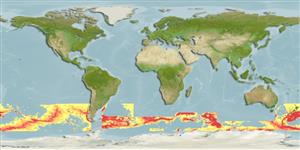>
Myctophiformes (Lanternfishes) >
Myctophidae (Lanternfishes) > Gymnoscopelinae
Etymology: Gymnoscopelus: Greek, gymnos = naked + Greek, skopelos, a lantern fish (Ref. 45335).
Eponymy: Dr Rolf Ling Bolin (1901–1973) was an American ichthyologist and marine biologist who was a specialist in lanternfish. [...] (Ref. 128868), visit book page.
More on author: Andriashev.
Environment: milieu / climate zone / depth range / distribution range
Écologie
marin benthopélagique; océanodrome (Ref. 51243); profondeur ? - 4200 m (Ref. 58018). Temperate; 34°S - 67°S, 58°W - 71°W
Generally ranges between Antarctic Polar Front and Subtropical Convergence, but with northern extension to about 38°S off Argentina, to 40°S off Chile and to 34°S in the southeast Atlantic.
Taille / Poids / Âge
Maturity: Lm ? range ? - ? cm
Max length : 28.0 cm SL mâle / non sexé; (Ref. 5182)
Description synthétique
Clés d'identification | Morphologie | Morphométrie
Épines dorsales (Total) : 0; Rayons mous dorsaux (Total) : 19 - 22; Épines anales: 0; Rayons mous anaux: 19 - 22.
Oceanic and mesopelagic (Ref. 4066). Found within the upper 200 m in the region of Antarctic Polar Front, but inhabits deeper northwards at night.
Life cycle and mating behavior
Maturité | Reproduction | Frai | Œufs | Fécondité | Larves
Hulley, P.A., 1990. Myctophidae. p. 146-178. In O. Gon and P.C. Heemstra (eds.) Fishes of the Southern Ocean. J.L.B. Smith Institute of Ichthyology, Grahamstown, South Africa. (Ref. 5182)
Statut dans la liste rouge de l'IUCN (Ref. 130435: Version 2024-1)
Menace pour l'homme
Harmless
Utilisations par l'homme
Pêcheries: intérêt commercial mineur
Outils
Articles particuliers
Télécharger en XML
Sources Internet
Estimates based on models
Preferred temperature (Ref.
123201): 1.5 - 5.6, mean 2.6 °C (based on 596 cells).
Phylogenetic diversity index (Ref.
82804): PD
50 = 0.5039 [Uniqueness, from 0.5 = low to 2.0 = high].
Bayesian length-weight: a=0.00407 (0.00223 - 0.00746), b=3.23 (3.06 - 3.40), in cm total length, based on LWR estimates for this species & (Sub)family-body (Ref.
93245).
Niveau trophique (Ref.
69278): 3.3 ±0.47 se; based on food items.
Résilience (Ref.
120179): Faible, temps minimum de doublement de population : 4,5 à 14 années (Preliminary K or Fecundity.).
Fishing Vulnerability (Ref.
59153): Low vulnerability (24 of 100).
Nutrients (Ref.
124155): Calcium = 36.7 [12.8, 91.2] mg/100g; Iron = 0.31 [0.14, 0.80] mg/100g; Protein = 15.5 [13.4, 17.7] %; Omega3 = 1.04 [0.45, 2.71] g/100g; Selenium = 31.7 [10.6, 91.5] μg/100g; VitaminA = 52.2 [10.4, 294.7] μg/100g; Zinc = 0.668 [0.390, 1.101] mg/100g (wet weight);
